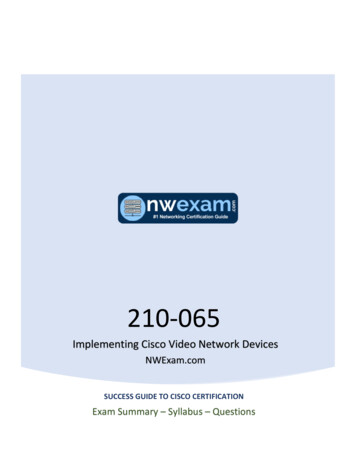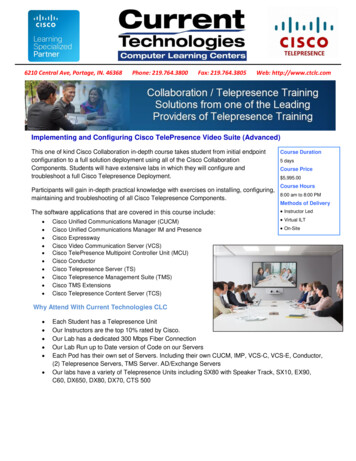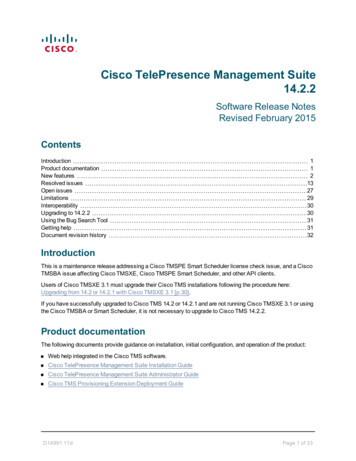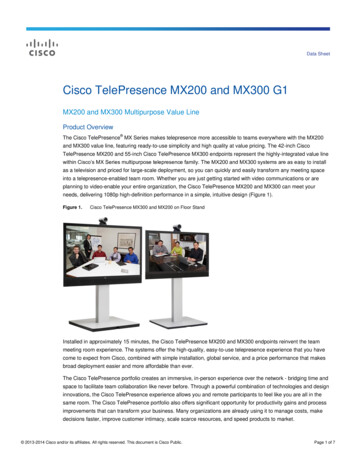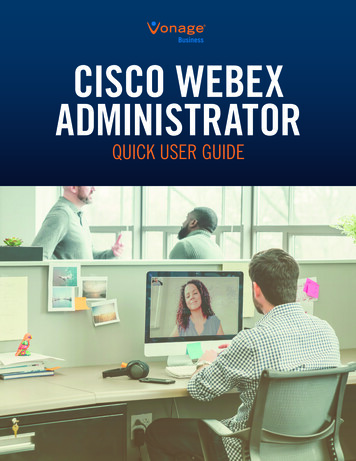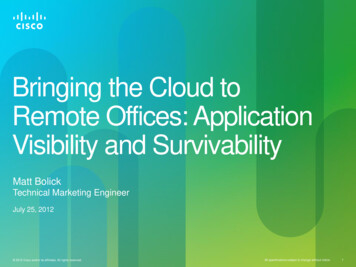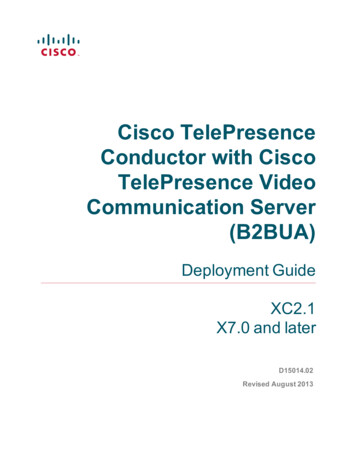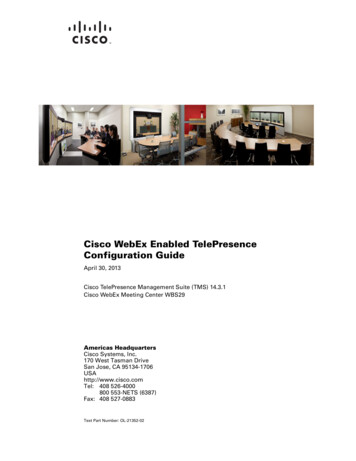
Transcription
Cisco WebEx Enabled TelePresenceConfiguration GuideApril 30, 2013Cisco TelePresence Management Suite (TMS) 14.3.1Cisco WebEx Meeting Center WBS29Americas HeadquartersCisco Systems, Inc.170 West Tasman DriveSan Jose, CA 95134-1706USAhttp://www.cisco.comTel: 408 526-4000800 553-NETS (6387)Fax: 408 527-0883Text Part Number: OL-21352-02
THE SPECIFICATIONS AND INFORMATION REGARDING THE PRODUCTS IN THIS MANUAL ARE SUBJECT TO CHANGE WITHOUT NOTICE. ALLSTATEMENTS, INFORMATION, AND RECOMMENDATIONS IN THIS MANUAL ARE BELIEVED TO BE ACCURATE BUT ARE PRESENTED WITHOUTWARRANTY OF ANY KIND, EXPRESS OR IMPLIED. USERS MUST TAKE FULL RESPONSIBILITY FOR THEIR APPLICATION OF ANY PRODUCTS.THE SOFTWARE LICENSE AND LIMITED WARRANTY FOR THE ACCOMPANYING PRODUCT ARE SET FORTH IN THE INFORMATION PACKET THATSHIPPED WITH THE PRODUCT AND ARE INCORPORATED HEREIN BY THIS REFERENCE. IF YOU ARE UNABLE TO LOCATE THE SOFTWARE LICENSEOR LIMITED WARRANTY, CONTACT YOUR CISCO REPRESENTATIVE FOR A COPY.The Cisco implementation of TCP header compression is an adaptation of a program developed by the University of California, Berkeley (UCB) as part of UCB’s publicdomain version of the UNIX operating system. All rights reserved. Copyright 1981, Regents of the University of California.NOTWITHSTANDING ANY OTHER WARRANTY HEREIN, ALL DOCUMENT FILES AND SOFTWARE OF THESE SUPPLIERS ARE PROVIDED “AS IS” WITHALL FAULTS. CISCO AND THE ABOVE-NAMED SUPPLIERS DISCLAIM ALL WARRANTIES, EXPRESSED OR IMPLIED, INCLUDING, WITHOUTLIMITATION, THOSE OF MERCHANTABILITY, FITNESS FOR A PARTICULAR PURPOSE AND NONINFRINGEMENT OR ARISING FROM A COURSE OFDEALING, USAGE, OR TRADE PRACTICE.IN NO EVENT SHALL CISCO OR ITS SUPPLIERS BE LIABLE FOR ANY INDIRECT, SPECIAL, CONSEQUENTIAL, OR INCIDENTAL DAMAGES, INCLUDING,WITHOUT LIMITATION, LOST PROFITS OR LOSS OR DAMAGE TO DATA ARISING OUT OF THE USE OR INABILITY TO USE THIS MANUAL, EVEN IF CISCOOR ITS SUPPLIERS HAVE BEEN ADVISED OF THE POSSIBILITY OF SUCH DAMAGES.CCDE, CCENT, CCSI, Cisco Eos, Cisco Explorer, Cisco HealthPresence, Cisco IronPort, the Cisco logo, Cisco Nurse Connect, Cisco Pulse, Cisco SensorBase,Cisco StackPower, Cisco StadiumVision, Cisco TelePresence, Cisco TrustSec, Cisco Unified Computing System, Cisco WebEx, DCE, Flip Channels, Flip for Good, FlipMino, Flipshare (Design), Flip Ultra, Flip Video, Flip Video (Design), Instant Broadband, and Welcome to the Human Network are trademarks; Changing the Way We Work,Live, Play, and Learn, Cisco Capital, Cisco Capital (Design), Cisco:Financed (Stylized), Cisco Store, Flip Gift Card, and One Million Acts of Green are service marks; andAccess Registrar, Aironet, AllTouch, AsyncOS, Bringing the Meeting To You, Catalyst, CCDA, CCDP, CCIE, CCIP, CCNA, CCNP, CCSP, CCVP, Cisco, theCisco Certified Internetwork Expert logo, Cisco IOS, Cisco Lumin, Cisco Nexus, Cisco Press, Cisco Systems, Cisco Systems Capital, the Cisco Systems logo, Cisco Unity,Collaboration Without Limitation, Continuum, EtherFast, EtherSwitch, Event Center, Explorer, Follow Me Browsing, GainMaker, iLYNX, IOS, iPhone, IronPort, theIronPort logo, Laser Link, LightStream, Linksys, MeetingPlace, MeetingPlace Chime Sound, MGX, Networkers, Networking Academy, PCNow, PIX, PowerKEY,PowerPanels, PowerTV, PowerTV (Design), PowerVu, Prisma, ProConnect, ROSA, SenderBase, SMARTnet, Spectrum Expert, StackWise, WebEx, and the WebEx logo areregistered trademarks of Cisco and/or its affiliates in the United States and certain other countries.Cisco and the Cisco Logo are trademarks of Cisco Systems, Inc. and/or its affiliates in the U.S. and other countries. A listing of Cisco's trademarks can be found atwww.cisco.com/go/trademarks. Third party trademarks mentioned are the property of their respective owners. The use of the word partner does not imply a partnershiprelationship between Cisco and any other company. (1005R)Any Internet Protocol (IP) addresses and phone numbers used in this document are not intended to be actual addresses and phone numbers. Any examples, command displayoutput, network topology diagrams, and other figures included in the document are shown for illustrative purposes only. Any use of actual IP addresses or phone numbers inillustrative content is unintentional and coincidental.Cisco WebEx Enabled TelePresence Configuration Guide 2013 Cisco Systems, Inc. All rights reserved.
CONTENTSPreface1General Description1Audience and Scope1Cisco WebEx Features and Important NotesSupported Features 2Feature Limitations 3Prerequisites24Document OrganizationRelated Documents56Obtaining Documentation and Submitting a Service Request7Information About the Cisco WebEx Enabled TelePresence FeatureContents1-11-1Cisco WebEx Enabled TelePresence Experience 1-1Scheduling the Meeting 1-1Starting/Joining the Meeting 1-2Cisco TelePresence Meeting Experience 1-2Cisco WebEx Meeting Experience 1-2Understanding How Cisco WebEx Enabled TelePresence is Deployed 1-6SIP Video, Presentation and Audio 1-6SIP Video, Presentation and PSTN Audio 1-7Cisco TMS Scheduling Role 1-9TelePresence Server and MCU Roles 1-9Presentation Display Details for Multiple Presenters 1-9Meeting Participant List 1-9Ports and Protocols Used in WebEx Enabled TelePresence 1-10Understanding Cisco WebEx Enabled TelePresence Scheduling Flow 1-10Scheduling with the Cisco WebEx and TelePresence Integration to OutlookScheduling with the Cisco Smart Scheduler 1-13Scheduling with the Cisco WebEx Scheduling Mailbox 1-151-11Understanding Cisco WebEx Enabled TelePresence Call Flow 1-16SIP Audio Call Flow 1-17TSP Audio Call Flow with API Command to Unlock Waiting Room 1-19TSP Audio Call Flow with Waiting Room and MCU/TelePresence Server as Host1-21Cisco WebEx Enabled TelePresence Configuration Guide - TMS 14.3.1 - WebEx Meeting Center WBS29OL-21352-021
ContentsWebEx Audio (PSTN) Call FlowFirst-Time Configuration ChecklistContents1-232-12-1Server and Site Access Checklist2-1Configuration Task Checklist 2-3Cisco MCU 2-3Cisco TelePresence Server 2-4Cisco Video Communications Server 2-4Cisco Unified Communications Manager 2-4Cisco TelePresence Management Suite 2-6Cisco TelePresence Management Suite Extension for Microsoft ExchangeCisco TelePresence Management Suite Provisioning Extension 2-8Configure Audio for Cisco WebEx Enabled TelePresence 2-9Cisco WebEx Site Administration 2-9Configuring Cisco MCU and TelePresence ServerContentsIntroduction2-73-13-13-1Required Settings for MCU 3-2SIP 3-2Content Mode 3-2Video and Audio Codecs 3-2Automatic Content Handover 3-3Recommended Settings for MCU 3-3Automatically Make Content Channel ImportantOutgoing Transcoded Codec 3-4Adaptive Gain Control 3-4Join and Leave Audio Notifications 3-5Encryption 3-5Required Settings for TelePresence ServerSIP 3-6Locally Managed Mode 3-6Automatic Content Handover 3-63-5Recommended Settings for TelePresence ServerDisplay Setting 3-7Configuring Call ControlIntroduction3-33-74-14-1Configuring Cisco TelePresence Video Communication Server Control and Expressway4-1Cisco WebEx Enabled TelePresence Configuration Guide - TMS 14.3.1 - WebEx Meeting Center WBS292OL-21352-02
ContentsPrerequisites 4-2Creating a New DNS Zone on VCS Expressway for WebEx 4-3Configuring Traversal Zones for MCUs with Encryption Enabled 4-4Configuring Cisco Unified Communications Manager 4-5Prerequisites 4-5Configuring a SIP Trunk Between Unified CM and VCS ControlConfiguring Certificates on Cisco VCS Expressway5-1Introduction 5-1VCS Expressway X8.1 Encryption Issue and WorkaroundsVideos Available4-55-15-2Supported Certificates5-2Generating a Certificate Signing Request (CSR)5-2Installing the SSL Server Certificate on the VCS Expressway5-6Configuring the Trusted CA Certificate List on the VCS Expressway 5-11Configuring the Trusted CA Certificate List on VCS Expressway X7.2.2 5-12Configuring the Trusted CA Certificate List on VCS Expressway Upgraded from X7.2.2 to X8.1Configuring the Trusted CA Certificate List on VCS Expressway X8.1 5-22Configuring Cisco TelePresence Management SuiteContents5-186-16-1Prerequisites6-1Configuring the Cisco WebEx Feature in Cisco TMS6-2Configuring WebEx Users in Cisco TMS 6-4User Requirements for Scheduling WebEx-enabled Meetings 6-4Configuring Automatic User Lookup from Active Directory 6-5How WebEx Bookings Work 6-6Configuring a Cisco WebEx Enabled TelePresence User in Cisco TMS6-6Configuring Port Reservations for MCU and TelePresence Server in Cisco TMSEnabling Port Reservations for MCU 6-7Enabling Port Reservations for TelePresence Server 6-7Configuring Hybrid Content Mode for MCU in Cisco TMS6-76-8Configuring Lobby Screen for TelePresence Server in Cisco TMS 6-8How the Lobby Screen Affects the First TelePresence Participant in a Meeting if the WebEx WelcomeScreen is Disabled 6-8Configuring Conference Settings in Cisco TMS 6-9Default Setup and Teardown Buffers 6-9Default Picture Mode 6-10Conference Connection/Ending Options 6-10Cisco WebEx Enabled TelePresence Configuration Guide - TMS 14.3.1 - WebEx Meeting Center WBS29OL-21352-023
ContentsConfiguring Single Sign On in Cisco TMS 6-11Prerequisites 6-12Configuring SSO in Cisco TMS 6-12Generating a Certificate for WebEx 6-13Enabling Partner Delegated Authentication on the WebEx site 6-16Enabling SSO in Cisco TMS 6-17Supported Configurations for TMS to Schedule on Behalf of the WebEx Host6-18Configuring Cisco TelePresence Management Suite Extension for Microsoft ExchangeContents7-1Prerequisites7-1Deployment Best Practices7-2Scheduling Options with TMSXE7-2Configuring Cisco TMSXE for the WebEx and TelePresence Integration to OutlookInstalling the Cisco TMS Booking Service 7-2Setting Up Communication Between Your WebEx Site and TMSXE 7-5Configuring Cisco TMSXE for the WebEx Scheduling Mailbox 7-6Configuring the WebEx Scheduling Mailbox in Microsoft ExchangeAdding the WebEx Mailbox to Cisco TMSXE 7-7Additional Recommendations 7-78-18-1Prerequisites8-1Introduction8-2User Access to Cisco TMSPE 8-2Creating a Redirect to Smart SchedulerAccess Rights and Permissions 8-3Time Zone Display 8-3How Smart Scheduler WorksLimitations8-38-38-4Configuring AudioContents7-27-6Configuring Cisco TelePresence Management Suite Provisioning ing SIP Audio for Cisco WebEx Enabled TelePresence 9-2Configuring the WebEx Site in Cisco TMS to Use SIP Audio 9-2Enabling Hybrid Audio on the WebEx Site 9-3Configuring PSTN Audio for Cisco WebEx Enabled TelePresence9-3Cisco WebEx Enabled TelePresence Configuration Guide - TMS 14.3.1 - WebEx Meeting Center WBS294OL-21352-02
ContentsConfiguring the WebEx Site in Cisco TMS to Use PSTN Audio 9-4Enabling Hybrid Mode on the WebEx Site 9-4Configuring PSTN Calls to Pass Through a PSTN Gateway to WebEx9-4Configuring TSP Audio for Cisco WebEx Enabled TelePresence 9-7Configuring MACC Domain Index and Open TSP Meeting Room Webex SettingsConfiguring the TSP Dial String 9-8Configuring How the Conference is Opened 9-9Configuring TSP Audio for the Meeting Organizer 9-11Overview of TSP Audio Configuration and Meetings 9-129-8Integrating Cisco TelePresence with Your Cisco WebEx Site Administration Account10-1Contents 10-1Integrating Cisco TelePresence with Your Cisco WebEx Site Administration Account 10-1Assigning the Meeting Center TelePresence Session Type 10-3Network-Based Recording of WebEx Enabled TelePresence Meetings 10-6Installing the WebEx and TelePresence Integration to Outlook 10-6Setting the Time Zone and Language Preferences for a User’s WebEx Account 10-8Configuring TSP Audio for a User’s WebEx Account 10-9Where to Go Next10-9Scheduling Cisco WebEx Enabled TelePresence MeetingsContents11-111-1Introduction11-2Scheduling WebEx Enabled TelePresence Meetings in Cisco TMS11-3Information, Tips and Known Issues About WebEx Enabled TelePresence MeetingsCisco TMS 11-5MCU and TelePresence Server 11-6Endpoints 11-6TMSXE 11-7WebEx 11-7TroubleshootingContents11-512-112-1Verifying and Testing 12-1Cisco WebEx Site Administration Online HelpTroubleshooting Tips 12-1Problems with Scheduling a Meeting 12-2Problems with Starting or Joining a MeetingProblems During a Meeting 12-4Problems with a TSP Audio Meeting 12-712-112-3Cisco WebEx Enabled TelePresence Configuration Guide - TMS 14.3.1 - WebEx Meeting Center WBS29OL-21352-025
ContentsProblems with TelePresence Server and MCU12-9Managing System Behavior 12-10Managing the Cisco WebEx Video View Window12-10Cisco WebEx Enabled TelePresence Configuration Guide - TMS 14.3.1 - WebEx Meeting Center WBS296OL-21352-02
PrefaceRevised: April 2014This preface describes the purpose, audience, organization, and conventions of the Cisco WebExEnabled TelePresence Configuration Guide - TMS 14.3.1 - WebEx Meeting Center WBS29 and providesinformation about new features and how to obtain related documentation.This preface describes the following topics: General Description, page 1 Audience and Scope, page 1 Cisco WebEx Features and Important Notes, page 2 Prerequisites, page 4 Document Organization, page 5 Related Documents, page 6 Obtaining Documentation and Submitting a Service Request, page 7General DescriptionThis document describes how to configure Cisco TelePresence applications forCisco WebEx-to-Cisco Telepresence interoperability. The Cisco WebEx Enabled TelePresenceConfiguration Guide - TMS 14.3.1 - WebEx Meeting Center WBS29 describes how to manage andmonitor scheduled meeting interoperability between Cisco TelePresence System (CTS), CiscoTelePresence Server or MCU multipoint meetings, Cisco TMS, Cisco Unified CommunicationsManager (Cisco Unified CM), Cisco Video Communication Server (VCS) and the Cisco WebExMeeting Center.Audience and ScopeThe Cisco WebEx Enabled TelePresence Configuration Guide - TMS 14.3.1 - WebEx Meeting CenterWBS29 is directed to administrators who will be configuring the TelePresence Server, MCU, Cisco TMS,Cisco VCS and/or the Cisco Unified CM to use Cisco WebEx features in Cisco TelePresence meetings.Cisco WebEx Enabled TelePresence Configuration Guide - TMS 14.3.1 - WebEx Meeting Center WBS29OL-21352-021
PrefaceCisco WebEx Features and Important NotesThis section contains the following feature information: Supported Features, page 2 Feature Limitations, page 3Supported FeaturesCisco WebEx Enabled TelePresence provides the following key features: Two-way video sharing with up to 720p screen resolution between the WebEx client andTelePresence endpoints Integrated audio and presentation sharing — including application and desktop content sharingcapability for all users in a meeting Integrated meeting scheduling using TelePresence Management Suite (Cisco TMS), which allowsyou to easily schedule Cisco WebEx Enabled TelePresence meetings Secure call control and connectivity enabled by media encryption provided by Cisco VCSExpressway Interoperability with third-party telepresence endpointsTable 1 lists Cisco WebEx Enabled TelePresence features.Table 1Cisco WebEx Enabled TelePresence FeaturesSupported FeatureDescriptionAudioCTS participants have two-way audio with the Cisco WebEx meeting participants using G.711.NoteHostNo presentation audio is sent from the Cisco WebEx side.All Cisco TelePresence participants and the meeting organizer can be the default hosts. TheMCU/TelePresence Server dials in at the meeting start time automatically to connect all TelePresenceparticipants. The MCU/TelePresence Server becomes the host if the meeting organizer has not joinedon WebEx yet. If the meeting organizer joins the meeting before the scheduled start time, they becomethe host.Cisco WebEx Enabled TelePresence Configuration Guide - TMS 14.3.1 - WebEx Meeting Center WBS292OL-21352-02
PrefaceTable 1Cisco WebEx Enabled TelePresence FeaturesSupported FeatureDescriptionSchedulingUse Cisco TMS, the WebEx and TelePresence Integration to Outlook, Smart Scheduler, or WebExScheduling Mailbox to schedule a Cisco TelePresence meeting with WebEx. Start your meeting eitherusing One-Button-to-Push (OBTP) from scheduled Cisco TelePresence endpoints or using theAutomatic Connect feature of Cisco TMS to connect all scheduled endpoints at the start time of yourmeeting.You can start the WebEx portion of a Cisco WebEx Enabled TelePresence meeting earlier than thescheduled time if you are the WebEx host. WebEx participants who try to join the WebEx meetingbefore the host, receive a message that the meeting has not started and they must wait to join until thescheduled start time or until after the WebEx host joins.NoteOnly scheduled meetings are supported for Cisco WebEx Enabled TelePresenceInteroperability; non-scheduled TelePresence participants who want to join a Cisco WebExenabled TelePresence meeting, must manually dial into the conference (MCU/TelePresenceServer) bridge. The meeting organizer can reserve ports for video dial-in participants whenscheduling the meeting.See the Cisco TelePresence Management Suite Administrator Guide for meeting schedulinginformation.SharingCisco TelePresence users can share a presentation by connecting the video display cable of theTelePresence endpoint to their computer. Supported video display interfaces include VGA, DVI,HDMI, DisplayPort and Mini DisplayPort.Cisco WebEx Meeting Center clients can share the desktop or a selected application. Endpoints viewand share Cisco WebEx presentation at 1024 x 768 (XGA) resolution.The resolution that endpoints are capable of sending may vary depending on the endpoint model, butthe TelePresence Server/MCU will transcode the presentation and send it to the WebEx cloud at1024x768 resolution.NoteTwo-way VideoThe Cisco TelePresence user that is sharing with the video display cable must exit theCisco WebEx Meeting Center client on their laptop before connecting the video display cable.If they do not, a window cascading effect can occur. For more information, refer to Chapter 12,“Managing the Cisco WebEx Video View Window”.Video quality is sent best effort from the Cisco TelePresence endpoint to Cisco WebEx and fromCisco WebEx to the Cisco TelePresence endpoint.The video from the CTS participants in the meeting are forwarded to the Cisco WebEx network, wherethey will be seen by Cisco WebEx participants along with other Cisco WebEx participants. Live videocan be sent at minimum in Common Intermediate Format (CIF) format at 30 frames per second, atapproximately 300-450 kbps up to a maximum of 720p.Presentations from the Cisco WebEx client are displayed on the local CTS projector, presentationdisplay or with Presentation-in-Picture (PiP), depending on the capabilities of your CTS.NoteAll Cisco WebEx-enabled TelePresence meetings require the use of a Cisco TelePresenceServer or MCU.Feature LimitationsFor a complete list of limitations and known issues for Cisco WebEx Enabled TelePresence, refer to theCisco WebEx Enabled TelePresence release notes.Cisco WebEx Enabled TelePresence Configuration Guide - TMS 14.3.1 - WebEx Meeting Center WBS29OL-21352-023
PrefacePrerequisitesTable 2 lists Cisco WebEx Enabled TelePresence feature prerequisites.Table 2Cisco WebEx with the Cisco TelePresence System PrerequisitesRequirementDescriptionCisco TelePresence ManagementSuite (Cisco TMS)Cisco TMS is required for scheduling Cisco WebEx Enabled TelePresence meetings.Cisco TelePresence ManagementSuite Extension for MicrosoftExchange (Cisco TMSXE)Cisco TMSXE is required for scheduling Cisco WebEx Enabled TelePresence meetingsthrough Microsoft Outlook using either the WebEx Productivity Tools Plug-in or WebExScheduling Mailbox Scheduling.Release 14.3.1 or later is required. (Release 14.3 or later is also required for support ofTSP audio with Cisco TelePresence Server.)Release 3.1 or later is required.Cisco TelePresence ManagementSuite Provisioning Extension(Cisco TMSPE)Cisco TMSPE is required for scheduling Cisco WebEx Enabled TelePresence meetingsusing Smart Scheduler.Release 1.1 or later is required.Use of Smart Scheduler does not require the TMS provisioning option key.NoteCisco TelePresence VideoCommunication Server (VCS)VCS Control and Expressway are a required as the call control solution.Release X7.2.2 or later is required.CautionCisco Unified CommunicationsManager (Unified CM)Customers using Static NAT on VCS Expressway X7.2.2 are highlyrecommended to not upgrade to X8.1. Because VCS Expressway X8.1 usesthe Ethernet 2 IP address for the media part in SDP, the media part of callswill fail. If you are already using static NAT with X8.1, refer to therecommended workarounds in Chapter 5, “VCS Expressway X8.1 EncryptionIssue and Workarounds”.Unified CM is an optional call control solution that can be used with VCS fordeployments with endpoints registered to Unified CM.Release 8.6.2 or higher is required. 9.1.1 is recommended.Cisco TelePresence ServerTelePresence Server can be used as a conference bridge for Cisco WebEx EnabledTelePresence meetings.Release 3.0 or later is required. Release 3.1 or later with a Third-Party Interop key isrequired for support of TSP audio.Cisco TelePresence MCUCisco TelePresence MCU can be used as a conference bridge for Cisco WebEx EnabledTelePresence meetings.Release 4.4 or later is required.Provisioning—Cisco TelePresencewith Cisco WebEx.1.The Cisco WebEx Meeting Center site must be running release T28.10 or higherwith the latest service pack.2.The Cisco WebEx site must be configured to support Cisco TelePresenceIntegration. See Chapter 10, “Integrating Cisco TelePresence with YourCisco WebEx Site Administration Account” for more information.Cisco WebEx Enabled TelePresence Configuration Guide - TMS 14.3.1 - WebEx Meeting Center WBS294OL-21352-02
PrefaceTable 2Cisco WebEx with the Cisco TelePresence System PrerequisitesRequirementDescriptionSupported EndpointsAny endpoint supported by TelePresence Server or MCU can join a Cisco WebExEnabled TelePresence meeting.Account Validation—MeetingEach user who is scheduling Cisco WebEx Enabled TelePresence meetings in Ciscoscheduler's Cisco WebEx account. TMS, must have a host account on the WebEx site.1.The WebEx account username and password must be added into to each meetingscheduler’s user profile in Cisco TMS, along with the WebEx site they will use forscheduling.2.Cisco TMS validates authorized Cisco WebEx account holders.NoteBandwidth and CPUpower—Recommendation forgood video quality and integratingthe Cisco TelePresence networkwith Cisco WebEx.WebEx password is not required if Single-Sign-On (SSO) is configured in TMS.See Chapter 6, “Configuring Cisco TelePresence Management Suite” for moreinformation.Network bandwidth should be at least 1.1 Mbps upstream between theMCU/TelePresence Server and WebEx. For example, if you are anticipating 5simultaneous Cisco WebEx calls, you will need to have five 1.1 Mbps bandwidthinstances.Suggested CPU power (depends on running applications) is dual core CPU, 2.5 GHzmemory running at least 2G.Cisco WebEx Client ResourceFor detailed requirements, refer to the Cisco WebEx Enabled TelePresence release notes.Requirements—Expected resourceallocation per meeting.Document OrganizationInformation about configuring and using the Cisco WebEx Enabled TelePresence is provided in thefollowing chapters: Chapter 1, “Information About the Cisco WebEx Enabled TelePresence Feature” Chapter 2, “First-Time Configuration Checklist” Chapter 3, “Configuring Cisco MCU and TelePresence Server” Chapter 4, “Configuring Call Control” Chapter 5, “Configuring Certificates on Cisco VCS Expressway” Chapter 6, “Configuring Cisco TelePresence Management Suite” Chapter 7, “Configuring Cisco TelePresence Management Suite Extension for Microsoft Exchange” Chapter 8, “Configuring Cisco TelePresence Management Suite Provisioning Extension” Chapter 9, “Configuring Audio” Chapter 10, “Integrating Cisco TelePresence with Your Cisco WebEx Site Administration Account” Chapter 11, “Scheduling Cisco WebEx Enabled TelePresence Meetings” Chapter 12, “Troubleshooting”Cisco WebEx Enabled TelePresence Configuration Guide - TMS 14.3.1 - WebEx Meeting Center WBS29OL-21352-025
PrefaceRelated DocumentsRelated TopicDocument LinkCisco TelePresence DocumentationCisco TelePresence Management Suite Cisco TelePresence Management SuiteCisco TelePresence Video Communication Server(VCS) Cisco TelePresence Video Communication ServerCisco Unified Communications Manager (UnifiedCM) Cisco Unified Communications ManagerCisco TelePresence Server Cisco TelePresence ServerCisco TelePresence MCU MCU 5300 Series MCU 4501 Series MCU 4500 Series MCU 4200 Series MCU MSE SeriesInformation about how to use Cisco WebExmeeting features. Go to your Cisco WebEx site home page. Log into your Cisco WebEx Meeting Center account and click onSupport User Guides in the left navigation pane.Specifying Cisco TelePresence Integrationoptions and managing your Cisco WebEx Site. Refer to Integrating Cisco TelePresence with Your Cisco WebExSite Administration Account. ts user guidelist.htmlCisco WebEx DocumentationCisco WebEx Enabled TelePresence DocumentationInformation for meeting organizers on how toschedule WebEx Enabled TelePresence meetingsCisco WebEx Enabled TelePresence Configuration Guide - TMS 14.3.1 - WebEx Meeting Center WBS296OL-21352-02
PrefaceObtaining Documentation and Submitting a Service RequestFor information on obtaining documentation, submitting a service request, and gathering additionalinformation, see the monthly What’s New in Cisco Product Documentation, which also lists all new andrevised Cisco technical documentation, at the following ew/whatsnew.htmlSubscribe to the What’s New in Cisco Product Documentation as a Really Simple Syndication (RSS) feedand set content to be delivered directly to your desktop using a reader application. The RSS feeds are a freeservice and Cisco currently supports RSS version 2.0.Cisco WebEx Enabled TelePresence Configuration Guide - TMS 14.3.1 - WebEx Meeting Center WBS29OL-21352-027
PrefaceCisco WebEx Enabled TelePresence Configuration Guide - TMS 14.3.1 - WebEx Meeting Center WBS298OL-21352-02
CH A P T E R1Information About the Cisco WebEx EnabledTelePresence FeatureRevised: August 2014ContentsThis chapter provides an overview of the Cisco WebEx Enabled TelePresence solution. It contains thefollowing sections: Cisco WebEx Enabled TelePresence Experience, page 1-1 Understanding How Cisco WebEx Enabled TelePresence is Deployed, page 1-6 Understanding Cisco WebEx Enabled TelePresence Scheduling Flow, page 1-10 Understanding Cisco WebEx Enabled TelePresence Call Flow, page 1-16Cisco WebEx Enabled TelePresence ExperienceThis section contains the following information about the Cisco WebEx Enabled TelePresence meetingexperience: Scheduling the Meeting, page 1-1 Starting/Joining the Meeting, page 1-2 Cisco TelePresence Meeting Experience, page 1-2 Cisco WebEx Meeting Experience, page 1-2Scheduling the MeetingThe meeting organizer can schedule the meeting using the Cisco WebEx and TelePresence Integrationto Outlook, Cisco Smart Scheduler, Cisco TelePresence Management Suite (Cisco TMS) or CiscoWebEx Scheduling Mailbox.For more information about how to schedule a meeting using the different scheduling options, refer toChapter 11, “Scheduling Cisco WebEx Enabled TelePresence Meetings”.Cisco WebEx Enabled TelePresence Configuration Guide - TMS 14.3.1 - WebEx Meeting Center WBS29OL-21352-021-1
Chapter 1Information About the Cisco WebEx Enabled TelePresence FeatureCisco WebEx Enabled TelePresence ExperienceStarting/Joining the MeetingThe meeting is started the following way: At the scheduled start time of the meeting, the MCU/TelePresence Server calls into WebEx.– If the WebEx host has not joined the meeting, the MCU/TelePresence Server becomes thedefault WebEx host.– If the WebEx host joins before the scheduled start time of the meeting, he/she becomes theWebEx host. TelePresence participants join the meeting.– If meeting was scheduled using Auto Connect, Cisco TMS dials and connects each supportedendpoint.– If meeting was scheduled using One-Button-to-Push (OBTP), participants using endpoints thatsupport OBTP press the button on their endpoint to join the meeting.– Participants using endpoints that don’t support either Auto Connect or OBTP, join the meetingby dialing the video dial-in number listed in the meeting invitation. WebEx Participants join the meeting using the link in the meeting invitation.Cisco TelePresence Meeting ExperienceCisco TMS is used to configure and manage the Cisco WebEx bridging feature in Cisco TelePresencemeetings. During the meeting, telepresence participants see live video of both WebEx participants andtelepresence participants.The Cisco WebEx bridging feature integrates the Cisco WebEx conferencing server with multipointmeetings on the Cisco TelePresence MCU or Cisco TelePresence Server. Cisco Telepresence callersconnect to meetings using One-Button-to-Push (OBTP) or Automatic Connect technology. TheMCU/TelePresence Server connects at the meeting start time, automatically connects with theCisco WebEx conference and joins the two meetings. Upon connecting with Cisco WebEx, theCisco Telepresence presentation screen shows a Welcome page.For presentation sharing, the TelePresence user connects the video display cable to their computer and(if required) presses a button to start sharing their presentation to TelePresence and WebEx participants.Video of the active speaker in the Cisco TelePresence system is streamed to the Cisco WebEx Web client.Cisco WebEx Meeting ExperienceRemote participants join the Cisco WebEx meeting by logging in to the Cisco WebEx Meeting CenterWeb and/or mobile clients*. Content shared from the Cisco TelePresence endpoint is displayedautomatically in the Cisco WebEx Meeting Center clients and Cisco WebEx participants can share theirdesktop or application with Cisco Telepresence endpoints. Cisco WebEx users see the live video of theactively speaking Cisco Tele
Contents 4 Cisco WebEx Enabled TelePresence Configuration Guide - TMS 14.3.1 - WebEx Meeting Center WBS29 OL-21352-02 Configuring Single Sign On in Cisco TMS 6-11 Prerequisites 6-12 Configuring SSO in Cisco TMS 6-12 Generating a Certificate for WebEx 6-13 Enabling Partner Delegated Authentication on the WebEx site 6-16 Enabling SSO in Cisco TMS 6-17 Supported Configurations for TMS to Schedule .
